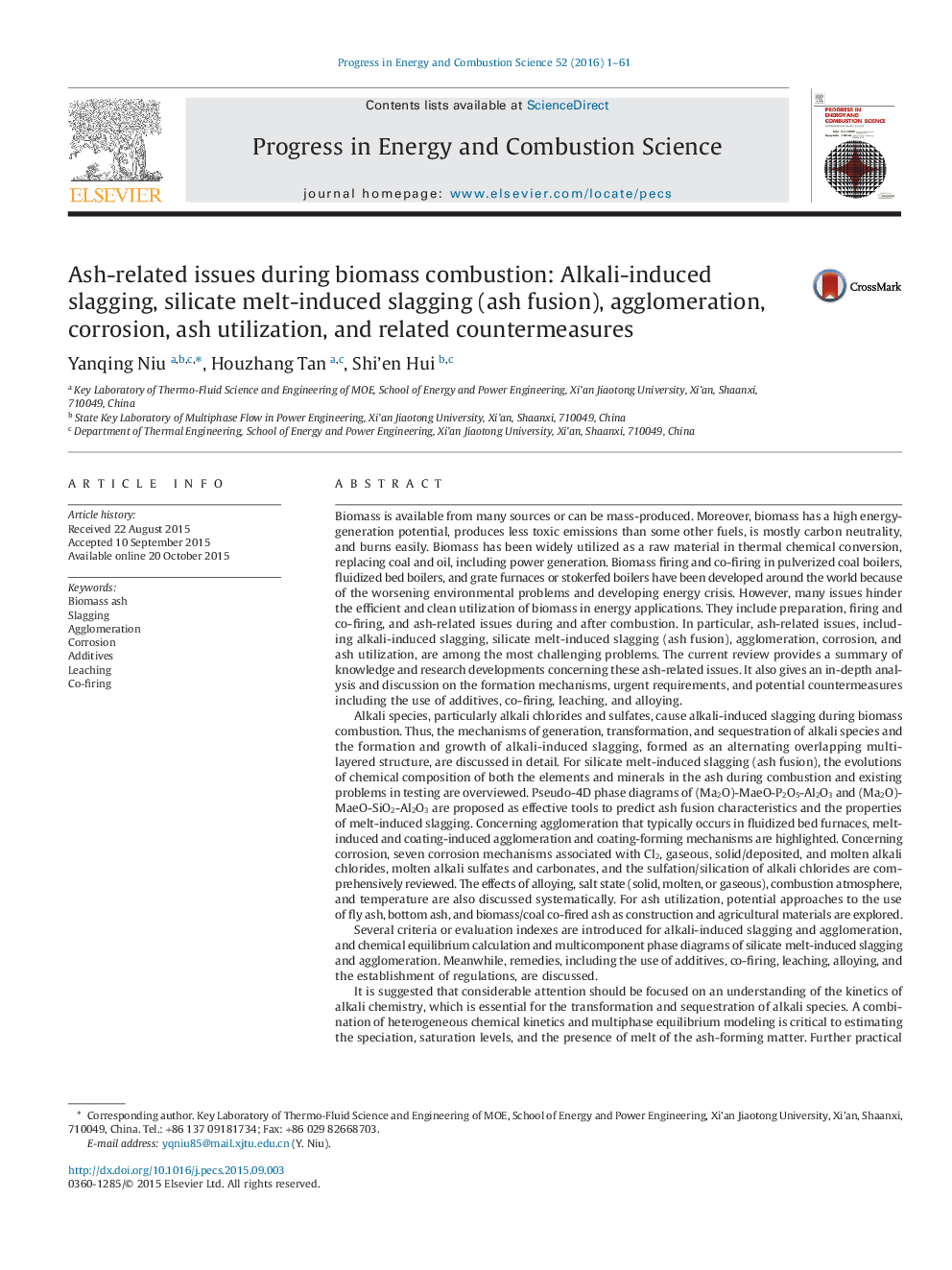| کد مقاله | کد نشریه | سال انتشار | مقاله انگلیسی | نسخه تمام متن |
|---|---|---|---|---|
| 241619 | 466291 | 2016 | 61 صفحه PDF | دانلود رایگان |
Biomass is available from many sources or can be mass-produced. Moreover, biomass has a high energy-generation potential, produces less toxic emissions than some other fuels, is mostly carbon neutrality, and burns easily. Biomass has been widely utilized as a raw material in thermal chemical conversion, replacing coal and oil, including power generation. Biomass firing and co-firing in pulverized coal boilers, fluidized bed boilers, and grate furnaces or stokerfed boilers have been developed around the world because of the worsening environmental problems and developing energy crisis. However, many issues hinder the efficient and clean utilization of biomass in energy applications. They include preparation, firing and co-firing, and ash-related issues during and after combustion. In particular, ash-related issues, including alkali-induced slagging, silicate melt-induced slagging (ash fusion), agglomeration, corrosion, and ash utilization, are among the most challenging problems. The current review provides a summary of knowledge and research developments concerning these ash-related issues. It also gives an in-depth analysis and discussion on the formation mechanisms, urgent requirements, and potential countermeasures including the use of additives, co-firing, leaching, and alloying.Alkali species, particularly alkali chlorides and sulfates, cause alkali-induced slagging during biomass combustion. Thus, the mechanisms of generation, transformation, and sequestration of alkali species and the formation and growth of alkali-induced slagging, formed as an alternating overlapping multi-layered structure, are discussed in detail. For silicate melt-induced slagging (ash fusion), the evolutions of chemical composition of both the elements and minerals in the ash during combustion and existing problems in testing are overviewed. Pseudo-4D phase diagrams of (Ma2O)-MaeO-P2O5-Al2O3 and (Ma2O)-MaeO-SiO2-Al2O3 are proposed as effective tools to predict ash fusion characteristics and the properties of melt-induced slagging. Concerning agglomeration that typically occurs in fluidized bed furnaces, melt-induced and coating-induced agglomeration and coating-forming mechanisms are highlighted. Concerning corrosion, seven corrosion mechanisms associated with Cl2, gaseous, solid/deposited, and molten alkali chlorides, molten alkali sulfates and carbonates, and the sulfation/silication of alkali chlorides are comprehensively reviewed. The effects of alloying, salt state (solid, molten, or gaseous), combustion atmosphere, and temperature are also discussed systematically. For ash utilization, potential approaches to the use of fly ash, bottom ash, and biomass/coal co-fired ash as construction and agricultural materials are explored.Several criteria or evaluation indexes are introduced for alkali-induced slagging and agglomeration, and chemical equilibrium calculation and multicomponent phase diagrams of silicate melt-induced slagging and agglomeration. Meanwhile, remedies, including the use of additives, co-firing, leaching, alloying, and the establishment of regulations, are discussed.It is suggested that considerable attention should be focused on an understanding of the kinetics of alkali chemistry, which is essential for the transformation and sequestration of alkali species. A combination of heterogeneous chemical kinetics and multiphase equilibrium modeling is critical to estimating the speciation, saturation levels, and the presence of melt of the ash-forming matter. Further practical evaluation and improvement of the existing criterion numbers of alkali-induced slagging and agglomeration should be improved. The pseudo-4D phase diagrams of (Ma2O)-MaeO-P2O5-Al2O3 and (Ma2O)-MaeO-SiO2-Al2O3 should be constructed from the data derived from real biomass ashes rather than those of simulated ashes in order to provide the capability to predict the properties of silicate melt-induced slagging. Apart from Cr, research should be conducted to understand the effects of Si, Al, and Co, which exhibit high corrosion resistance, and heavy metals such as Zn and Pb, which may form low-melting chlorides that accelerate corrosion. Regulations, cooperation among biomass-fired power plants and other industries, potential technical research, and logistics should be strengthened to enable the extensive utilization of biomass ash. Finally, alkali-induced slagging, silicate melt-induced slagging, agglomeration, and corrosion occur concurrently, and thus, these issues should be investigated jointly rather than separately.
Journal: Progress in Energy and Combustion Science - Volume 52, February 2016, Pages 1–61
